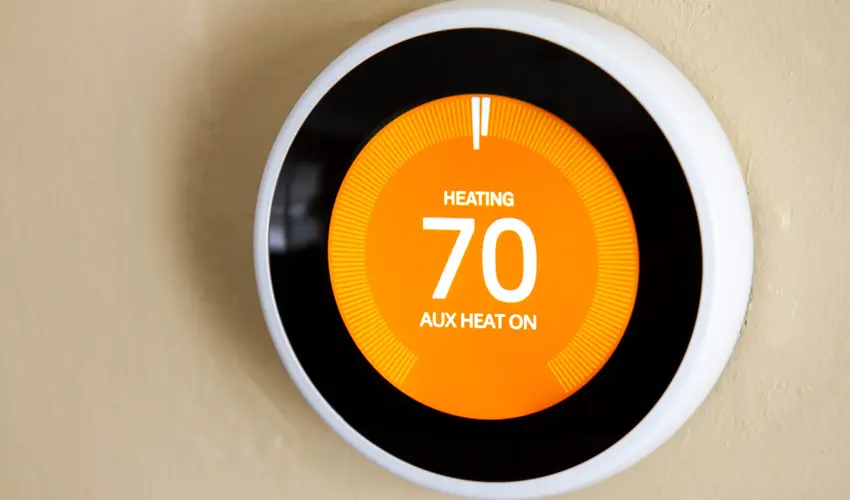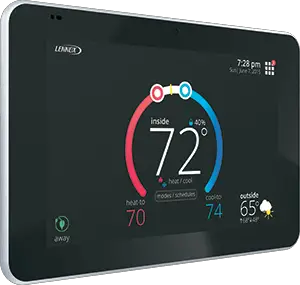Check Best Thermostat Pricing in Amazon
** As an Amazon Associate, I earn from qualifying purchases.
Your thermostat settings control your home’s temperature, ensuring comfort and energy efficiency. Key settings include heating, cooling, and fan modes.
Understanding your thermostat settings can make a significant difference in your home’s comfort and energy bills. Thermostats typically have three main modes: heating, cooling, and fan. The heating mode warms your home, while the cooling mode lowers the temperature. The fan setting circulates air without changing the temperature.
Modern thermostats often feature programmable options, allowing you to set specific temperatures for different times of the day. Learning to use these settings effectively can lead to a more comfortable living space and reduced energy costs. By mastering your thermostat, you can achieve optimal home comfort and efficiency.

Credit: candcheat.com
Decoding Your Thermostat
Your thermostat is the heart of your home’s comfort. Understanding its settings can save you money and energy. Let’s break down the settings and symbols on your thermostat.
Symbols And Their Functions
Thermostats use symbols to indicate different functions. Knowing these symbols helps you use your thermostat effectively.
- Snowflake: This symbol means cooling mode. Your air conditioner will turn on.
- Sun: This symbol means heating mode. Your heater will turn on.
- Fan: The fan symbol shows that the fan is running. It can run with or without heating or cooling.
- Clock: This symbol indicates a schedule is set. Your thermostat will follow the programmed times.
Traditional Vs. Smart Thermostats
Thermostats come in two types: traditional and smart. Each has its own features and benefits.
| Feature | Traditional Thermostat | Smart Thermostat |
|---|---|---|
| Ease of Use | Simple and manual | Advanced and automated |
| Programming | Limited to basic schedules | Customizable schedules and remote control |
| Energy Efficiency | Depends on manual setting | Optimizes for energy savings |
| Connectivity | Not connected to the internet | Wi-Fi enabled, can connect to apps |
Traditional thermostats require you to change settings manually. They are straightforward but less flexible. Smart thermostats offer more control and convenience. You can adjust settings from your phone or computer. They can learn your habits and optimize your home’s temperature automatically.
Temperature Adjustment Basics
Your thermostat settings can seem confusing at first. Understanding the basics helps you make your home comfortable and save energy. Knowing how to adjust the temperature correctly can help you feel comfortable all year round.
Setting Your Ideal Temperature
Finding the right temperature for your home is essential. It’s usually a balance between comfort and energy savings. Here’s a simple guide:
- Winter: Set your thermostat to around 68°F when you are home. Lower it when you sleep or are away.
- Summer: Aim for 78°F when you are home. Increase the temperature when you are away to save energy.
These settings can reduce your energy bills while keeping your home comfortable. Experiment with a few degrees up or down to find what works best for you.
Auto Vs. Manual Modes
Understanding the difference between Auto and Manual modes can make your life easier.
| Mode | Description |
|---|---|
| Auto Mode | Your thermostat adjusts the temperature automatically based on your settings. It maintains the temperature within a set range. This mode is energy-efficient and convenient. |
| Manual Mode | You set the temperature manually. The thermostat maintains this temperature until you change it. This mode gives you complete control but can be less energy-efficient. |
Using Auto mode can save time and energy. Manual mode is best if you prefer complete control over your home’s temperature.
Scheduling For Efficiency
Understanding how to schedule your thermostat can save you money and energy. Efficient scheduling ensures your home stays comfortable while optimizing energy use. This section helps you master thermostat scheduling for maximum efficiency.
Programming Your Week
Programming your thermostat for the week can make a big difference in your energy bill. Set different temperatures for weekdays and weekends based on your routine.
- Weekdays: Set a lower temperature during work hours when no one is home.
- Evenings: Schedule a comfortable temperature for when you return home.
- Nights: Lower the temperature while you sleep.
- Weekends: Adjust the settings to match your activities at home.
Most modern thermostats allow for multiple settings per day. Use these to your advantage for both comfort and efficiency.
Vacation Mode Essentials
Vacation mode is a special setting that helps save energy while you’re away. It keeps your home at a safe temperature without wasting energy.
Follow these steps to use vacation mode:
- Activate Vacation Mode: Find the vacation mode option on your thermostat.
- Set the Duration: Enter the dates you’ll be away.
- Choose a Temperature: Select a lower or higher temperature than usual.
Vacation mode prevents your heating or cooling system from running unnecessarily. This feature ensures your home is energy efficient even when you’re not there.
Understanding Fan Settings
Knowing what the fan settings on your thermostat mean can greatly improve your comfort and efficiency. The fan settings control how your HVAC system circulates air. Two main options are the Auto Fan and Continuous Fan settings. Let’s explore these options in detail.
Auto Fan Option
The Auto Fan setting runs the fan only when the system is heating or cooling. This is the default setting on most thermostats. It helps save energy and reduces wear on the fan motor.
| Benefits | Drawbacks |
|---|---|
|
|
In the Auto setting, the fan will turn on only when the system is actively heating or cooling. This helps maintain a balanced temperature with less energy use.
Continuous Fan Benefits
The Continuous Fan setting keeps the fan running all the time. This option ensures constant air circulation, even when the system is not heating or cooling.
- Improved air quality: Continuous air flow filters the air more frequently.
- Even temperature distribution: Prevents hot and cold spots in your home.
- Comfort: Provides a consistent and comfortable environment.
Running the fan continuously can improve indoor air quality. It keeps the air moving and reduces allergens. It can also make the temperature more even throughout your home.
Choosing the right fan setting depends on your needs. If you want to save energy, use the Auto Fan setting. If you prefer better air quality and even temperatures, consider the Continuous Fan option.
Heat Mode Versus Cool Mode
Understanding the settings on your thermostat can help you maintain a comfortable home environment. Two of the most important settings are Heat Mode and Cool Mode. Knowing how to use these settings effectively can save you money and energy.
When To Use Each
Heat Mode is used during the colder months. This setting activates your heating system to warm up your home. The thermostat will maintain the temperature you set by turning the heater on and off.
Check Best Thermostat Pricing in Amazon
** As an Amazon Associate, I earn from qualifying purchases.
On the other hand, Cool Mode is ideal for the warmer months. This setting activates your air conditioning system to cool down your home. The thermostat will work to keep your home at the desired cool temperature.
| Mode | Season | Function |
|---|---|---|
| Heat Mode | Winter | Activates heating system |
| Cool Mode | Summer | Activates air conditioning |
Transitioning Between Modes
To transition between Heat Mode and Cool Mode, follow these simple steps:
- Locate the mode switch on your thermostat.
- Switch from Heat to Cool, or vice versa.
- Set your desired temperature.
It’s essential to make this switch as the seasons change. This ensures your home stays comfortable year-round.
Some modern thermostats offer an Auto Mode. This mode can automatically switch between heating and cooling. It maintains a consistent temperature without manual adjustments.
The Role Of The ‘hold’ Feature
The ‘Hold’ feature on your thermostat can be very useful. It allows you to manually set and maintain a specific temperature. This feature is great for avoiding constant adjustments. Understanding how to use it can save energy and improve comfort.
Using ‘hold’ Wisely
Using the ‘Hold’ feature wisely can help manage your home’s temperature efficiently. Here are some tips:
- Set it and forget it: Use ‘Hold’ when leaving for vacations or extended periods.
- Energy savings: Maintain an energy-efficient temperature when no one is home.
- Consistency: Avoid frequent temperature changes that can strain your HVAC system.
Temporary Vs. Permanent Hold
Understanding the difference between Temporary and Permanent Hold is crucial. Each serves a unique purpose.
| Feature | Temporary Hold | Permanent Hold |
|---|---|---|
| Duration | Until the next scheduled change | Until manually changed |
| Usage | Short-term adjustments | Long-term stability |
| Energy Efficiency | Moderate | Can be high if set wisely |
Temporary Hold is perfect for short-term changes. It reverts to the schedule once the hold period ends. This is ideal for a one-time event like a party or a hot day.
Permanent Hold keeps the temperature fixed until you manually change it. This is useful for long vacations or maintaining a constant temperature. Remember to reset it to avoid wasting energy.
Auxiliary Heat Explained
Understanding your thermostat settings can help you save energy and money. One important setting is Auxiliary Heat or Aux Heat. This feature is part of many heat pump systems. It helps provide extra warmth when needed.
Auxiliary Heat kicks in during very cold weather. It acts as a backup to your main heating system. Knowing how Aux Heat works can help you manage your energy use efficiently.
What Triggers Aux Heat?
Several factors can trigger Aux Heat:
- Outdoor Temperature: When it gets very cold outside, the heat pump may struggle to keep your home warm. Aux Heat provides extra warmth in these conditions.
- Thermostat Settings: If you set your thermostat to a much higher temperature than the current room temperature, Aux Heat may turn on to reach the desired temperature quickly.
- Defrost Cycle: During the defrost cycle of a heat pump, Aux Heat may activate to maintain indoor warmth.
Minimizing Aux Heat Usage
Using Aux Heat can increase your energy bills. Here are some tips to minimize its usage:
- Set a Moderate Temperature: Avoid setting your thermostat to a high temperature. Gradually increase the temperature to reduce the need for Aux Heat.
- Insulate Your Home: Proper insulation helps keep your home warm. This reduces the need for Auxiliary Heat.
- Regular Maintenance: Keep your heating system in good condition. Regular maintenance ensures it runs efficiently, reducing the need for Aux Heat.
By understanding how Auxiliary Heat works and taking steps to minimize its use, you can save energy and reduce your heating costs.

Credit: www.reddit.com
Energy-saving Tips
Understanding the settings on your thermostat can help you save energy and reduce your utility bills. By optimizing your thermostat, you can ensure your home stays comfortable while using less energy. Below are some energy-saving tips to help you get started.
Optimizing Thermostat Settings
Optimizing your thermostat settings is key to saving energy. Here are some tips:
- Set your thermostat to 78°F in the summer when you are home. This keeps you cool without using too much energy.
- Lower it to 68°F in the winter when you are awake and at home. This is comfortable and energy-efficient.
- Use the “away” setting to save energy when you are not home. Set it to 85°F in the summer and 55°F in the winter.
- Install a programmable thermostat to automatically adjust the temperature based on your schedule. This can save you money without any extra effort.
Regular Maintenance Checks
Regular maintenance checks ensure your thermostat works efficiently. Follow these steps:
- Check and replace air filters every 1-3 months. Clean filters improve airflow and efficiency.
- Inspect thermostat batteries regularly and replace them as needed. Weak batteries can cause your thermostat to malfunction.
- Calibrate your thermostat annually to ensure it reads the correct temperature. This helps maintain accurate settings.
- Schedule professional HVAC maintenance at least once a year. A technician can identify and fix issues you might miss.
By following these energy-saving tips, you can maximize your thermostat’s efficiency and keep your home comfortable all year round.

Credit: www.aireserv.com
Frequently Asked Questions
What Are The Settings On A Thermostat?
Thermostat settings include temperature, mode (heating, cooling, auto), fan speed, and scheduling. Adjust them for comfort and energy efficiency.
What Are The Best Temperature Settings For Thermostat?
For optimal comfort and energy savings, set your thermostat to 68°F (20°C) in winter and 78°F (26°C) in summer.
What Do The Buttons On A Thermostat Mean?
The buttons on a thermostat control temperature, mode (heat/cool), fan settings, and scheduling. They help manage indoor climate efficiently.
What Are The Systems Mode On A Thermostat?
Thermostat system modes include Heat, Cool, Off, and Auto. Heat warms your home, Cool provides air conditioning, Off turns the system off, and Auto switches between heating and cooling based on the set temperature.
Conclusion
Understanding your thermostat settings can improve comfort and energy efficiency. Adjusting the temperature wisely can save money. Use this guide to make informed choices. Enjoy a cozy home environment year-round. Keep these tips in mind for optimal thermostat performance.
Check Best Thermostat Pricing in Amazon
** As an Amazon Associate, I earn from qualifying purchases.


